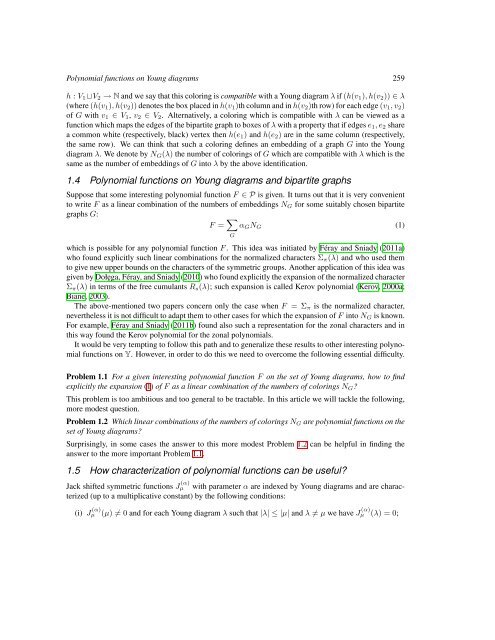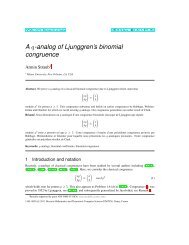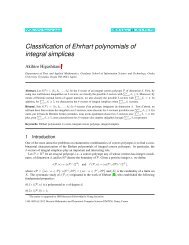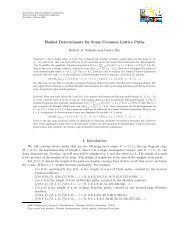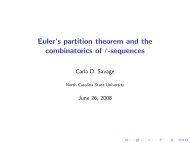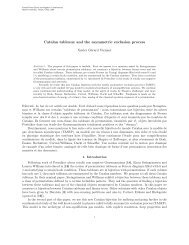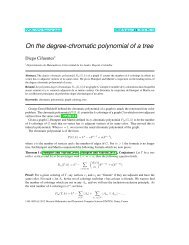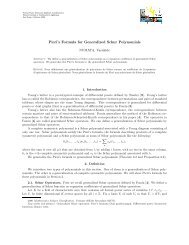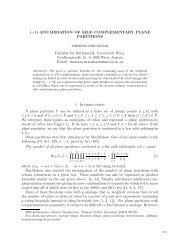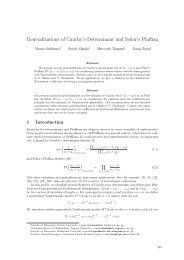Polynomial functions on Young diagrams arising from bipartite graphs
Polynomial functions on Young diagrams arising from bipartite graphs
Polynomial functions on Young diagrams arising from bipartite graphs
You also want an ePaper? Increase the reach of your titles
YUMPU automatically turns print PDFs into web optimized ePapers that Google loves.
<str<strong>on</strong>g>Polynomial</str<strong>on</strong>g> <str<strong>on</strong>g>functi<strong>on</strong>s</str<strong>on</strong>g> <strong>on</strong> <strong>Young</strong> <strong>diagrams</strong> 259<br />
h : V 1 ⊔V 2 → N and we say that this coloring is compatible with a <strong>Young</strong> diagram λ if (h(v 1 ), h(v 2 )) ∈ λ<br />
(where (h(v 1 ), h(v 2 )) denotes the box placed in h(v 1 )th column and in h(v 2 )th row) for each edge (v 1 , v 2 )<br />
of G with v 1 ∈ V 1 , v 2 ∈ V 2 . Alternatively, a coloring which is compatible with λ can be viewed as a<br />
functi<strong>on</strong> which maps the edges of the <strong>bipartite</strong> graph to boxes of λ with a property that if edges e 1 , e 2 share<br />
a comm<strong>on</strong> white (respectively, black) vertex then h(e 1 ) and h(e 2 ) are in the same column (respectively,<br />
the same row). We can think that such a coloring defines an embedding of a graph G into the <strong>Young</strong><br />
diagram λ. We denote by N G (λ) the number of colorings of G which are compatible with λ which is the<br />
same as the number of embeddings of G into λ by the above identificati<strong>on</strong>.<br />
1.4 <str<strong>on</strong>g>Polynomial</str<strong>on</strong>g> <str<strong>on</strong>g>functi<strong>on</strong>s</str<strong>on</strong>g> <strong>on</strong> <strong>Young</strong> <strong>diagrams</strong> and <strong>bipartite</strong> <strong>graphs</strong><br />
Suppose that some interesting polynomial functi<strong>on</strong> F ∈ P is given. It turns out that it is very c<strong>on</strong>venient<br />
to write F as a linear combinati<strong>on</strong> of the numbers of embeddings N G for some suitably chosen <strong>bipartite</strong><br />
<strong>graphs</strong> G:<br />
F = ∑ α G N G (1)<br />
G<br />
which is possible for any polynomial functi<strong>on</strong> F . This idea was initiated by Féray and Śniady (2011a)<br />
who found explicitly such linear combinati<strong>on</strong>s for the normalized characters Σ π (λ) and who used them<br />
to give new upper bounds <strong>on</strong> the characters of the symmetric groups. Another applicati<strong>on</strong> of this idea was<br />
given by Dołęga, Féray, and Śniady (2010) who found explicitly the expansi<strong>on</strong> of the normalized character<br />
Σ π (λ) in terms of the free cumulants R s (λ); such expansi<strong>on</strong> is called Kerov polynomial (Kerov, 2000a;<br />
Biane, 2003).<br />
The above-menti<strong>on</strong>ed two papers c<strong>on</strong>cern <strong>on</strong>ly the case when F = Σ π is the normalized character,<br />
nevertheless it is not difficult to adapt them to other cases for which the expansi<strong>on</strong> of F into N G is known.<br />
For example, Féray and Śniady (2011b) found also such a representati<strong>on</strong> for the z<strong>on</strong>al characters and in<br />
this way found the Kerov polynomial for the z<strong>on</strong>al polynomials.<br />
It would be very tempting to follow this path and to generalize these results to other interesting polynomial<br />
<str<strong>on</strong>g>functi<strong>on</strong>s</str<strong>on</strong>g> <strong>on</strong> Y. However, in order to do this we need to overcome the following essential difficulty.<br />
Problem 1.1 For a given interesting polynomial functi<strong>on</strong> F <strong>on</strong> the set of <strong>Young</strong> <strong>diagrams</strong>, how to find<br />
explicitly the expansi<strong>on</strong> (1) of F as a linear combinati<strong>on</strong> of the numbers of colorings N G ?<br />
This problem is too ambitious and too general to be tractable. In this article we will tackle the following,<br />
more modest questi<strong>on</strong>.<br />
Problem 1.2 Which linear combinati<strong>on</strong>s of the numbers of colorings N G are polynomial <str<strong>on</strong>g>functi<strong>on</strong>s</str<strong>on</strong>g> <strong>on</strong> the<br />
set of <strong>Young</strong> <strong>diagrams</strong>?<br />
Surprisingly, in some cases the answer to this more modest Problem 1.2 can be helpful in finding the<br />
answer to the more important Problem 1.1.<br />
1.5 How characterizati<strong>on</strong> of polynomial <str<strong>on</strong>g>functi<strong>on</strong>s</str<strong>on</strong>g> can be useful?<br />
Jack shifted symmetric <str<strong>on</strong>g>functi<strong>on</strong>s</str<strong>on</strong>g> J (α)<br />
µ with parameter α are indexed by <strong>Young</strong> <strong>diagrams</strong> and are characterized<br />
(up to a multiplicative c<strong>on</strong>stant) by the following c<strong>on</strong>diti<strong>on</strong>s:<br />
(i) J (α)<br />
µ (µ) ≠ 0 and for each <strong>Young</strong> diagram λ such that |λ| ≤ |µ| and λ ≠ µ we have J (α)<br />
µ (λ) = 0;


